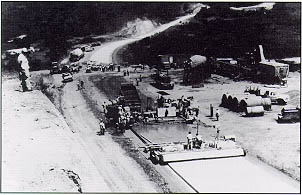June 9
| 1967 | Frank Turner, Director of FHWA's BPR, says the last slab of concrete has been poured on a 63-mile stretch of the Inter-American Highway in Panama, bypassing a primitive, dangerous road between Guabala and Santiago, cutting the 3-hour driving time in half. The project, which included the first use of slip-form paving in Latin America, ends the United States' 30-year participation in Panama highway construction.
| |
| 1976 | FHWA announces Demonstration Project No. 39, "Recycling Asphalt Pavement." The announcement notes that the energy crisis following an oil embargo (see October 17, 1973) had created new concerns about our energy supply. "This crisis, coupled with rising costs, material scarcities, and the diminishing proximity of quality aggregates, has seriously affected the highway industry." Demonstration Project No. 47, "Recycling Portland Cement Concrete Pavements," will be announced on May 5, 1978. | |
| 1998 | In a ceremony in the Old Executive Office Building, President Bill Clinton signs the Transportation Equity Act for the 21st Century (TEA-21), which reauthorizes Federal-aid highway, transit, and safety programs through FY 2003. He says that TEA-21 "will strengthen America by modernizing and building roads, bridges, transit systems, and railways to link our people and our country together and to permit a freer flow of goods." |

